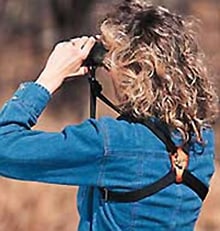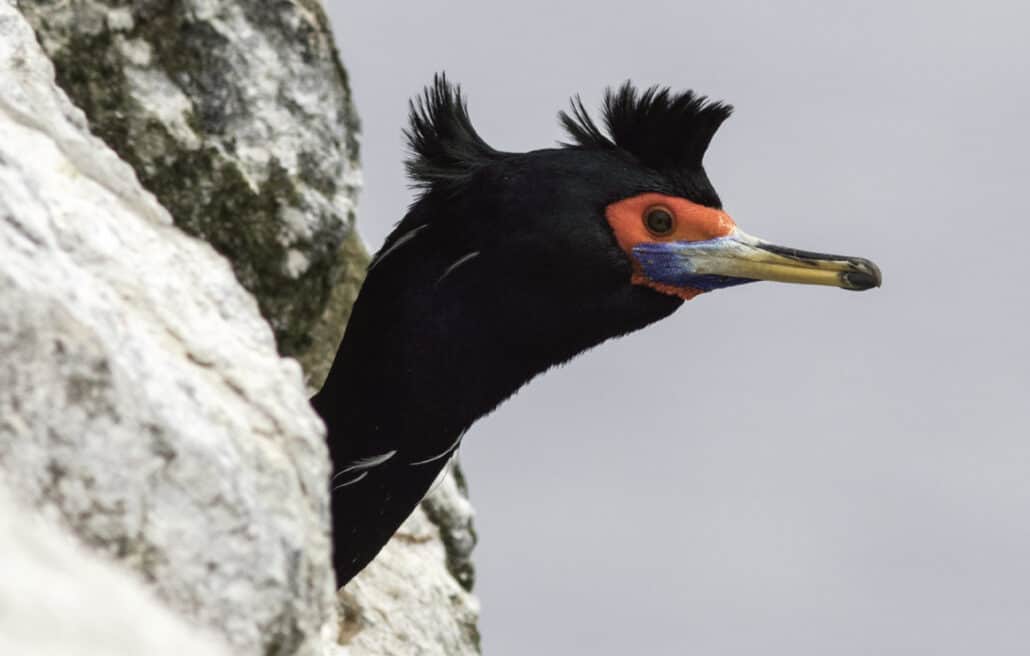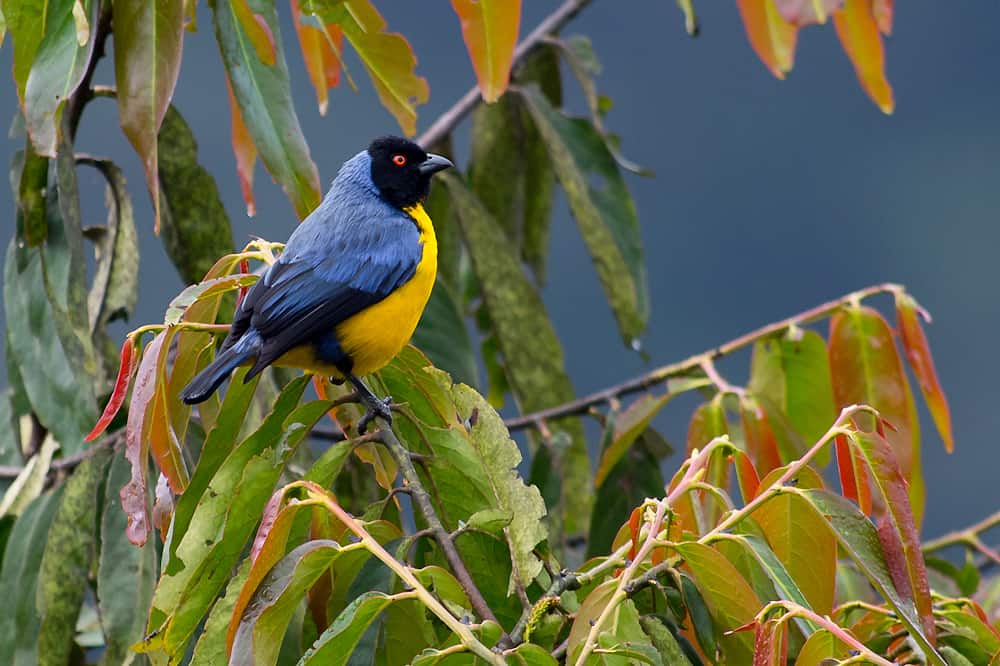Are your binoculars a pain in the neck? I mean that literally. After an hour of birding is your neck sore? Is there a dull ache in your shoulders? Do you feel a dead weight hanging from your neck? These common complaints can all be traced directly to your binoculars.
Actually the cause of these problems is not your binoculars. The real culprit is the neck strap on your binoculars. Binoculars can weigh as much as two pounds. All this weight transfers directly to your neck through the narrow neck strap. This full weight continually bites into your neck, often for several hours.
Every time you take a step, your binoculars bounce and the jolt digs into your neck. When you bend, they sway. If you duck under a branch, they swing, causing further strain to your neck muscles. Unfortunately, neck muscles are not designed for this kind of punishment. No wonder your neck gets sore!
The neck straps supplied with most new binoculars, even very expensive optics, are often inadequate for the purpose. The typical neck strap is a thin, hard plastic strip about one-half inch wide. It is too narrow and too inflexible. The full weight of your binoculars hangs by this skinny strap. Only a short section of the strap, maybe four or five inches, actually rests on the back of your neck.
In technical terms, if your binoculars weigh two pounds and your strap is only one-half inch wide, your neck feels a constant pressure of one pound per square inch. That may not sound like much. But over a long period of time, the continual pressure takes its toll.
Fortunately, there are ways to reduce or eliminate the strain and the resulting soreness in your neck. The solution is to remove the factory-equipped strap on your binoculars and throw it away. Replace it with a different, better strap. There are several commercially available straps specifically designed to ease neck pain.
A simple approach is to use a wider strap. Replace the half-inch wide strap with one that is one to two inches wide. A wider strap spreads the total weight over a larger area, thus reducing the concentrated stress on your neck. If you double the width of your strap, you cut the pressure in half.
Tripling the strap width, reduces the pressure to one-third. Have you ever noticed the straps used by bird photographers toting heavy cameras with long lenses? Their straps are very wide, maybe up to three inches wide. The greater the width of the strap, the lower the pressure becomes in each square inch.
Check out various camera straps at your local camera or optic store. Or scan the advertisements for mail-order camera and optics firms in magazines. They will carry wider straps.
You can also find commercial neck straps that go one step farther. These straps reduce not only the stress, but also the sudden jolts and jarring pains that shoot through your neck when your binoculars bounce as you stoop under a limb or hop from rock to rock. Standard neck straps, made of hard, rigid material, transfer the complete shock to your neck. Commercial replacement straps utilize flexible, soft materials.
Replacement neck straps made of such soft, stretchable material are available commercially at a relatively modest price. BWD Direct, for example, offers a binocular/camera strap made of a soft, comfortable neoprene material. This material stretches and “gives” to absorb shocks.
The strap is also wider than average (1.5 inches), distributing the weight over a larger area. In addition to the increased width, the strap is also extra thick, with at least one-quarter inch of foam cushioning that further absorbs shocks and provides padding against sudden jolts. The overall result makes heavy binoculars feel lighter than they really are. The strap is washable and durable.
These comfortable straps are available in a choice of bright colors, or you can choose basic black. I find the brightly colored straps are easier to find in the typical birder’s car that is often filled with food, clothing, maps, field guides, and a large assortment of miscellany.
Another important feature of straps is the ability to adjust the length to match your specific needs. Birders come in different heights, and different body types, from thin to rotund. One fixed length of strap cannot be the correct length for all birders. Straps should be adjustable to compensate for the differences in people. It is common to see many birders, particularly shorter people, with straps that are far too long.
Binoculars should rest on your chest. If the straps are too long, they rest on your belly. This extra strap length allows your binoculars to swing and sway excessively as you move and bend. Not only is the excess movement uncomfortable, but there is also a potential for damage to your binoculars if they swing into the ground or hit a rock.
Adjust the length of your strap to your body size. When you make the adjustment, I advise that you wear the bulky sweater or jacket that you would wear in colder weather. If you adjust your straps without making allowance for bulky clothing, the resulting length may be too short when you don your cold-weather clothing.
So far we have talked about the traditional strap for holding binoculars that consists of a simple loop around your neck. This design concentrates all of the strain directly on your neck muscles. Fortunately, this simple loop design is not the only strap system that can be used for holding binoculars or cameras.
Other strap design systems have been developed to eliminate concentrated stress. These alternate systems remove the concentration from your neck and transfer more of the weight to other parts of the body. Consider backpackers who often tote packs that weigh between 20 and 50 pounds.
They don’t use a simple loop around the neck. Backpacks use a strap system that concentrates the weight onto the shoulders and back instead of the neck muscles. If these strap systems can help make the weight of a 20-pound backpack more tolerable, image how effective the same strap design would be if it were applied to your binoculars. They would feel light as a feather.
There are several simple but ingenious strapping systems available that lighten and transfer weight to your shoulders and back instead of your neck. One inexpensive system (about $12) is constructed of stretchable nylon cording. In principle, it uses four straps instead of the traditional single loop or strap. None of the four straps goes over your neck. Two go over your shoulders and two go under your arms.
They join in an X-type configuration in the middle of your back. The four-strap design divides and reduces the pressure on each strap and is fairly comfortable. Despite its small size, this flexible strap system is surprisingly effective. Your binoculars feel significantly lighter, with absolutely no strain on the neck. As an added benefit, this strapping system holds your binoculars closer to your chest.
It eliminates all swinging and swaying of your binoculars, even if you are running. In rugged or steep areas where you are constantly hopping from rock to rock, the reduction of binocular bounce is a definite benefit. This inexpensive system is easy to use. It is readily adjustable to fit your body size and type.

The Bino System harness is another system that uses a somewhat similar four-strap design concept. The Bino System harness uses wide stretchable straps instead of narrow elastic cords. These soft, flexible straps are not only very comfortable, but also spread the weight evenly on your shoulders and upper back with absolutely no pressure on the weak and tender area of your neck.
You don’t put the Bino System harness on by lifting it over your head. You slip into it like slipping into a vest. There is no chance of knocking off your hat or eyeglasses or even messing your hair. It slips on and off easily even if you are wearing a heavy parka, rain gear, or a hat.
This fully adjustable harness system keeps binoculars secure but readily available. Quick-connect plastic clips attach the strap to your binoculars. Using plastic rather than metal clips prevents scratches to your binoculars. The quick-connect feature allows you easily to remove your binoculars and connect your camera if you wish to take photographs to record a sighting.
A more radical approach to eliminating neck soreness is to completely eliminate the neck straps. Without straps there is no pain or strain. I’m not recommending that you simply carry your binoculars in your hands. It would be too easy to drop them. Rather, I’m suggesting that you attach your binoculars to a tripod.
The result is a clear, hands-free view with no vibration and no strain on your neck. With high-magnification optics, it is difficult to hold binoculars steady. Mounting them on a tripod provides a stable platform, keeps your hands free for making notes or checking a field guide, and allows others to share the steady view.
No one likes a pain in the neck. If your pain is caused by the strap on your binoculars, you don’t have to continue to live with the pain. Remove the strap that came with your binoculars. Replace it with an improved strap. Eliminate the strain from your neck, and your bird watching will be more enjoyable.




